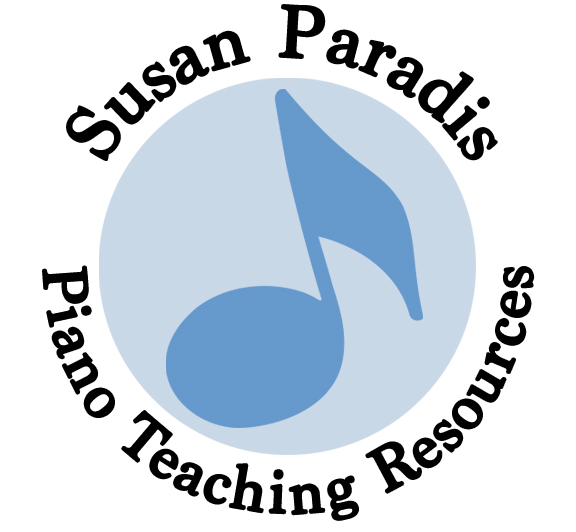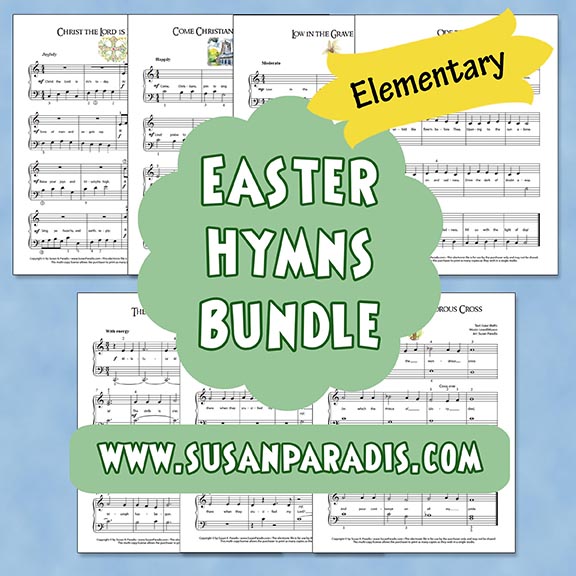Christ the Lord Is Risen Today – an Easy Version
Click here to purchase.
This arrangement of Christ the Lord Is Risen Today is found in a bundle for students who want to play easy arrangements of Easter Hymns. This arrangement requires students to shift hands and play some patterns that are not exactly in 5-finger patterns. You will notice this is not as easy as it looks and sounds. The left hand accompaniment in the second measure of the “Alleluia” pattern (the end of each line) can be omitted if it proves to be too difficult. Help your student with the first measure of the last line. That is a tricky passage, as well as the left hand of the last measure. If it is too difficult, try omitting the left hand when it doesn’t have the melody.
This is one of my favorite Easter hymns. The lyrics were written by Charles Wesley (the Anglican Church pastor and the founder of the Methodist movement in the U.S.) and the music is attributed to Lyra Davidica, which is obviously not a person’s name. I am a history buff and I was curious about that, so in my usual way, I did some research.
It turns out that Lyra Davidica ( David’s Harp) was hymn book published in 1708. The full title is Lyra Davidica, or a Collection of Divine Songs and Hymns, partly newly composed, partly translated from the High German and Latin Hymns; and set to easy and pleasant tunes). It seems the English were rather envious of the German’s “pleasant and tuneful melodies,” so this book was a way to bring some of those tunes to England. What musician wouldn’t be jealous of the Germans, who produced some of the greatest musicians who ever lived! Fortunately for English speakers, we were able to nab Handel! 😉
Thanks to the IMSLP Music Library, which has a huge data base of public domain classical music, I was able to look through every page of this old hymn book and see the original melody, which is evidently an anonymous tune. It was slightly more flourisher, but basically the same. Was the composer German? We will never know. The words, of course, are different, since Charles Wesley was born in 1703, but the original tune has Easter lyrics.
Hymn books of that time were very different from hymn books we use now. The old hymn books would alternate between hymns with music notation and other hymns with the verses only and no notation. It is interesting that nowadays in some churches the same thing is done, with the lyrics being projected on a screen or written in a church bulletin with no accompanying music notation.
This is a very old hymn, and the fact that it is still around says something about both the music and the lyrics. I hope by encouraging our students to learn some of these hymns, we can pass along our music legacy.




Susan thank you so muh for your resources!!!! They’re so great!
I love this song. I am so excited to start my students working on it. Thanks so much!
Thanks for letting me know, Jennifer. Just today I am starting to re-do all my sacred music, so I’m happy to know that someone uses it. It is going to take me a while, because the files are so old I’m going to have to start over. (Sometimes I post things and never really know if they get used so I really appreciate comments!)
Thank you, Susan, for the arrangement and the historical context!
Thanks for your comment, Leila. Do you enjoy knowing the history of things as much as I do?!
Thank you VERY MUCH Susan. This hymn is a favourite of mine too. You are so kind to share your excellent talent for good arranging. My students will benefit greatly from this.
Thank you so much, Susan! This is my very favorite hymn and I know some of my students will be excited to try it. And being able to give them a bit of background on it will make it even more interesting so thanks for that as well!
You’re welcome, Leisa.